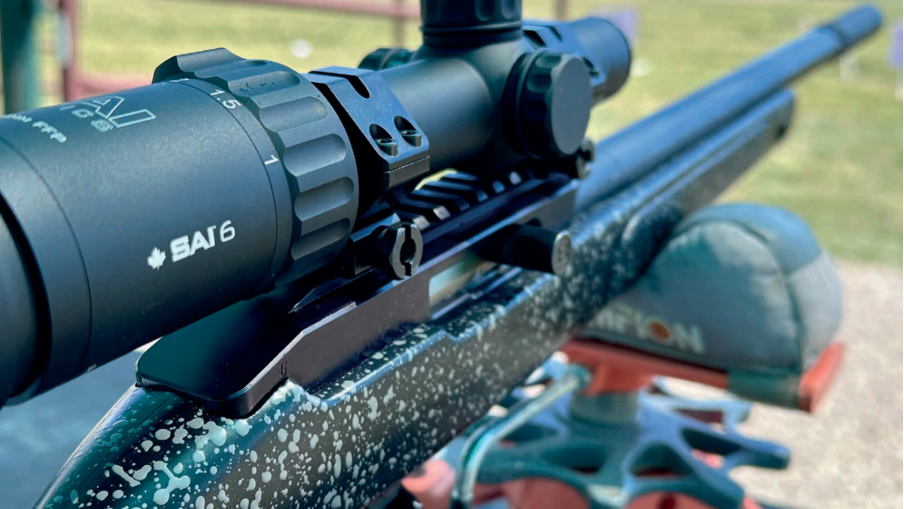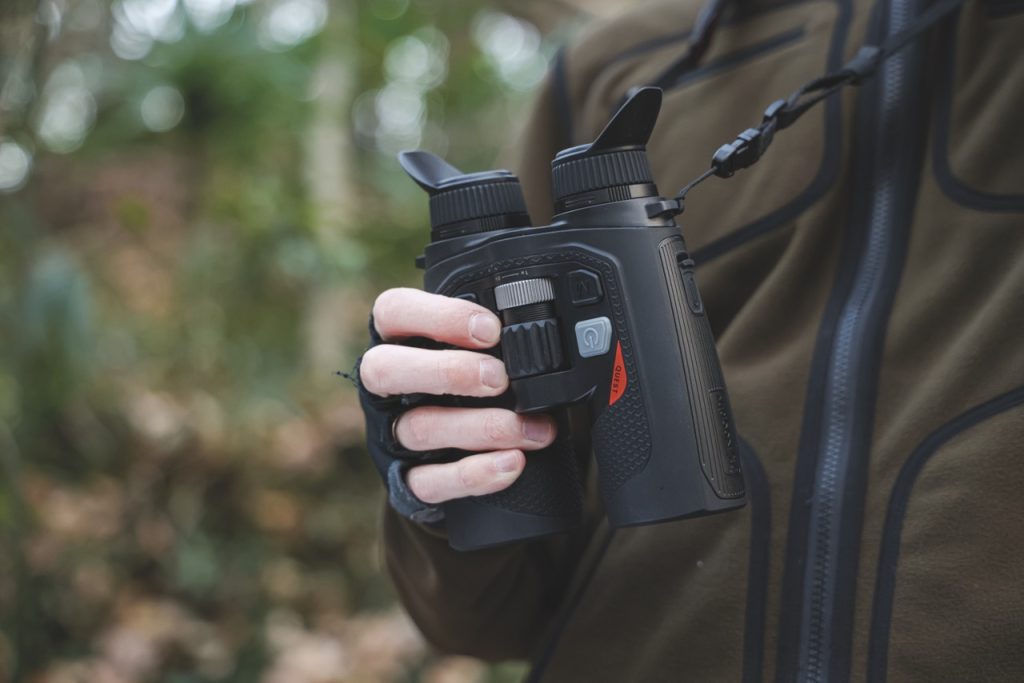- News
- Gundogs
- Shooting
- Recipes
- Gear
-
-
- More
-
-
More
-
-
News
Rural concerns risk being sidelined in devolution shake-up
By Hollis Butler (Group News Editor)
-
News
Crimestoppers under fire over snitch campaign targeting certificate holders
By Hollis Butler (Group News Editor)
-
-
-
Win CENS ProFlex DX5 earplugs worth £1,149 – enter here
Beyond the scope
The latest riflescopes won’t break the bank and they offer the shooter a wide range of invaluable features, says Andrew McKean

The variety and talents of the all-round, do-everything riflescopes that have appeared on the market this year has never been greater. Their number includes compact low-power variable optics (LPVO) that make wonderful stalking scopes, mid-magnification stubbies that are optimised for use with clip-on thermals, and a pleasing number of classic configurations with updated turrets and reticles that can handle all manner of hunting and target duties.
Some of the scopes in this roundup were introduced early last year but are only just coming to market now. Others are brand new for 2025. Given their prodigious features, at under £2,000 these desirable optics can be considered true bargains for the abundant value they deliver.
GPO CENTURI
A new scope line from GPO, the mid-priced Centuri is available in four configurations with a number of reticle choices. The value proposition of the line – which is built for the American market but available in the UK, southern Africa, Australia and New Zealand – is a wide range of attributes in a fairly compact package. Features include exposed zero-stopped turrets, second-plane illuminated reticles, 30mm tubes and a free custom-engraved elevation turret.
Available configurations include 2.5-15×44, 2.5-15×50, 3-12×44 and 4-16×44. Perhaps the most appealing of the lot is the Super Compact 3-12×44 with G4 reticle, which mounts on just about any lightweight rifle and has a sufficiently short build to accept a clip-on thermal easily. Prices average around £599 regardless of configuration.
BUSHNELL R5
A new line for this American brand, the R5 replaces the Forge as the mid-level scope in its good/better/best hierarchy. Bushnell also released its R3 last year, which replaces the Nitro line at the entry level. You can expect to see an R7 later this year, which will be Bushnell’s more premium offering.
All these R series scopes deliver better glass and more precise controls than the retired Nitro/Forge/Prime lines. I tested the R3 in a 3-9×40 configuration and the R5 in the more capable 4-12×40 configuration. Both are built on 1in tubes with capped turrets and second-plane reticles, but the R5 brings a lot more to hunters than the pedestrian R3.
My test sample had Bushnell’s bullet-drop compensating DOA reticle with holdover references out to 800 yards. It features a six-step red centre dot illumination and side parallax that focuses targets from 10 yards to infinity. The re-zeroable turrets are tuned to .25 MOA click values and have 60 MOA of total internal adjustment. Adding to its feature set, the reticle has wind holds for 5mph and 10mph crossing winds and shooters can connect to Bushnell’s ballistic app to tune their loads to the bullet-drop references in the reticle.
The glass is only adequate, but that’s to be expected for a scope that retails for £295.
LEUPOLD MARK 4HD
If the market for Leupold’s new VX-6HD Gen 2 is the upper end of the destination-hunting crowd, the brand’s 2024 introduction aims at the meaty middle of the market. The Mark 4HD product line is a very appealing kitchen-sink collection that includes a little bit of everything: first- or second-plane reticles for crossover hunting and precision shooters, reticle references in either MOA or MIL, illuminated reticles in some models, side parallax, exposed push-to-turn locking turrets, 30mm and 34mm tubes depending on configuration, three-revolution elevation turrets, and impressive internal adjustment ranges.
As its name suggests, the Mark 4HD line is built on 4x magnification ratio and is available in these configurations: 1-4.5×24 and 2.5-10×42 built on 30mm tubes and 4.5-18×52, 6-24×52, 8-32×56, all built on 34mm tubes.
Among the most appealing attributes of the Mark 4HD lineup are the prices. On average, individual scopes retail for about £1,000 less than equivalent scopes in Leupold’s Mark 5HD line or the new VX-6HD Gen 2 collection. I tested four scopes in the Mark 4HD line ahead of their mid-2024 introduction: the versatile 1-4.5x24mm LPVO, which retails for a little over £1,000; the 2.5-10×42, which is perfect for hill stalking and retails for £1,269; the 4.5-18×52 (£1,899), which is a good choice for shooters who want a crossover scope for target shooting and stalking; and the 6-24×52 (£1,779), which has precision-target talents. The 8-32×56 costs about £1,899.
The value proposition of the Mark 4HD line is its precise, repeatable controls, selectable reticles and bomb-proof build. The glass is good but not awe-inspiring. But if you’re in the market for a durable scope that can handle target duties in the close season and any number of hunting chores, it’s a collection that has enough variation for just about any shooting situation.
ARMAMENT TECHNOLOGY S AI6
One of a class of versatile LPVO scopes, the 1-6×24 SAI6 is intended for use on tactical AR-style carbines. But don’t let the configuration fool you; this is a scope that’s just at home on a big game bolt rifle, a lightweight stalking rifle or a rimfire target rig.
The heart of the 30mm scope is its first-plane RAF (rapid aiming feature) reticle that illuminates from a subtle glow to a blazingly bright red that’s visible in broad daylight. It should be noted that Canada-based Armament Technology delivers many of its optics to be used by the military, but the precision references of the reticle make this optic perfectly suitable for use in wide-open countryside. The scope, which is only 10in long and weighs just over a pound, is the very definition of versatility because it can mount on just about every class of gun, regardless of purpose. The 1-6×24 marvel retails for £1,399.
VORTEX VIPER HD
Vortex has had the best-selling Viper line in its catalogue for more than a decade, but the new HD iteration has better glass, illuminated reticles in first or second focal plane, and capped or exposed turrets. As that à la carte description indicates, there’s a configuration available for just about any hunter.
That’s an important point. While these new 30mm Viper HD scopes can capably serve shooters, they’re aimed squarely at hunters, as the configurations indicate. The new line is available in a 2-10×42 SFP (second focal plane), 3-15×44 SFP and 5-25×50 in either SFP or first focal plane (FFP). The reticles are similarly geared towards hunters, with Vortex’s Dead-Hold BDC, VMR-3 in either MOA or MRAD calibrations, and VMR-4 in either MOA or MRAD.
Compared with the original Viper line, the new HD model has noticeably better glass and more precise, repeatable controls. Pricing for the new model is in what might be called the sub-premium category, with the 2-10x version retailing for £629, the 3-15x scope selling for £779, and the 5-25x version going for £1,059.
ZEISS CONQUEST V4
Engineered for the US market, this updated version of the popular Conquest line has plenty of appeal for continental hunters. It’s built on a 30mm tube and comes in 3-12×44, 3-12×56, 4-16×50 and 6-24×50 versions. All feature non-illuminated reticles, capped turrets and second-plane reticles. The higher-magnification models have side parallax.
Like Leupold’s Mark 4HD line, the Zeiss Conquest V4 line is situated either at the high end of the budget-scope market or the low end of the premium-scope class. The 3-12×56 versions retail for about £800 while the higher-mag versions go for £1,275.
These models represent Zeiss’s move towards the American premium-budget market, but there’s plenty of value for European hunters. They are available in either the ZMOAi reticle or the ZBi reticle, both designed for hunting in open terrain or over long distances. Traditional hunters will appreciate the #60 duplex of the BT versions of the V4. All models feature Zeiss’s excellent glass and T* coatings as well as durability-tested builds.
BURRIS VERACITY PH
One of the most interesting and useful scopes of the year is the new Veracity PH, the second generation of Burris’s smart scope, which melds digital and optical technology to enable shooters to dial the elevation turret to a specific distance and then follow in-scope prompts to the correct holdover adjustment.
Once you’ve calibrated the scope to your specific load and rifle, making first-hit shots is as simple as ranging the target, dialling the turret to the distance, then holding for wind. But that simple process relies on a fair amount of prior work to tune the scope.
Beyond its digital brain, the scope has an elegant clickless turret technology, good glass, a smart and useful first-plane hunting reticle, and connectivity to the very good BurrisConnect mobile app. That app is an important partner in its performance, porting ballistic information from your phone into the scope in order to inform the smart turret.
The system works across calibres and is as useful for mid-range hunters as it is to long-range precision target shooters. The scope works just fine if the battery dies, though it will force you to revert to old-fashioned skills such as dialling the elevation turret based on your understanding of MOA rather than letting the scope calculate the hold. The 4-20×50 version of the Veracity PH retails for about £1,200.
STEINER RANGER 4
This compact, feature-rich scope represents a new type of versatile hunting scope that is configured for use with clip-on thermals. The 4-16×44 version I tested weighs just over 18oz and is sized to neatly fit on a lightweight rifle. Its 10.9in length is its superpower, because even with a clip-on thermal attached to its objective bell, its controls are an comfortable reach for a shooter behind the rifle.
Even without an attached electronic, the Ranger 4 has plenty of attributes for most hunting situations. Its second-plane E3 illuminated reticle has three ballistic holdover references and three windage hashes on either side of its illuminated center cross. Built on a 30mm tube, the scope has capped turrets and side parallax control. At £1,100, the Steiner is fairly priced for a versatile hunting optic.
Related Articles
Get the latest news delivered direct to your door
Subscribe to Shooting Times & Country
Discover the ultimate companion for field sports enthusiasts with Shooting Times & Country Magazine, the UK’s leading weekly publication that has been at the forefront of shooting culture since 1882. Subscribers gain access to expert tips, comprehensive gear reviews, seasonal advice and a vibrant community of like-minded shooters.
Save on shop price when you subscribe with weekly issues featuring in-depth articles on gundog training, exclusive member offers and access to the digital back issue library. A Shooting Times & Country subscription is more than a magazine, don’t just read about the countryside; immerse yourself in its most authoritative and engaging publication.







